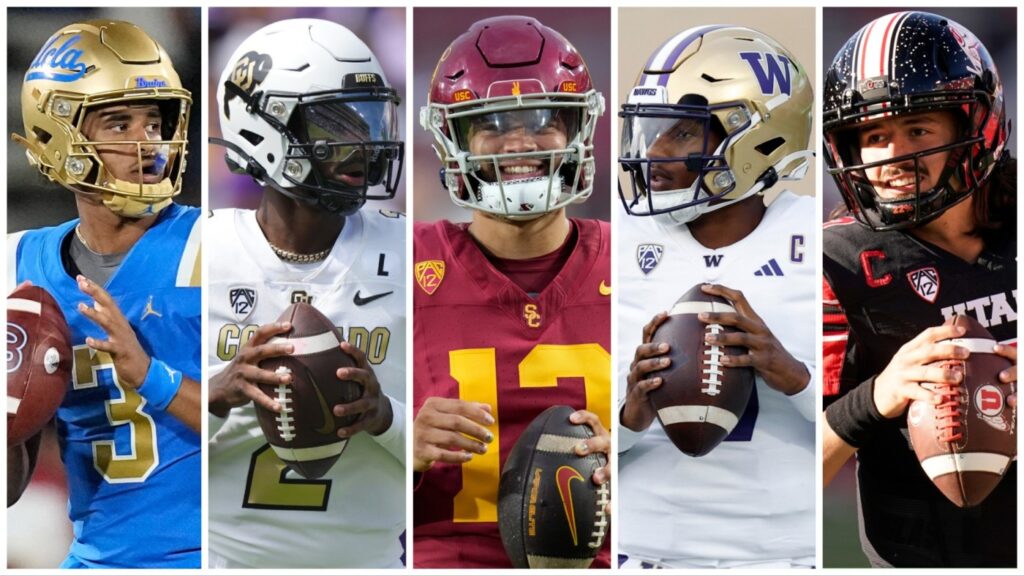
Really, every week until the bye week was a bye week.
After three weeks of virtual tune-up games against overmatched San Jose State, Nevada and Stanford squads – to make nothing of Saturday’s upcoming road tilt against an Arizona State squad that was down to its QB4 last week – USC football will hit a gauntlet beginning bright and early in Boulder on Sept. 30.
A gauntlet, truly, because from the ashes of the Pac-12 has risen the conference’s most dynamic football product in a long while. Washington’s Michael Penix Jr. is perhaps the mightiest challenger to Caleb Williams’ bid for back-to-back Heisman Trophies; Oregon and Utah are reloaded, undefeated and vying for a shot at the conference crown; and Colorado’s transfer-rich turnaround has become so scintillating in the “Coach Prime” era that Clippers star Kawhi Leonard, of all people, made an appearance at the Buffs’ game last weekend. Through four weeks, much of the national collegiate football zeitgeist has centered, improbably, out west: eight Pac-12 schools are ranked in AP’s current Top 25 poll, more than any other conference.
Now, from a 30,000-foot-view that requires absolutely no knowledge of USC’s season or football in general, that spells trouble for USC’s chances at a long-desired College Football Playoff appearance.
The CFP is shifting to a 12-team bracket in 2024. But as presently constructed, only four teams are selected. Thus, given that the Southeastern, Big Ten, Big 12 and Atlantic Coast conferences will all likely field worthy contenders come selection time (think Georgia, Michigan, Texas and more), the Trojans would need an emphatic run through the Pac-12 to merit strong consideration.
But the Pac-12’s strength – not the most top-heavy but the deepest conference in the FBS through the early part of this season – should give its eventual champion an inherent advantage. USC’s schedule through the rest of the season, in particular, boasts six teams currently ranked in the AP poll. The CFP committee doesn’t consider such arbitrary ranking systems in its final determinations, executive director Bill Hancock told the Southern California News Group – but a team that plays in a strong conference schedule will “be better off” than one who doesn’t, Hancock said.
“There is no doubt, starting with the committee – when they start meeting October 30th, that it will know who played a strong schedule,” Hancock said. “And a team benefits from being in a conference with other good teams. Absolutely.”
One of the most important factors in CFP selection, Hancock said, is “relative statistics” – the concept of measuring teams against one another by how well they performed against other team’s established results. Hancock’s explanation, in simpler terms:
“If you gained 400 yards against an opponent who only gives up 100 yards per game,” Hancock said, “that’s quite an accomplishment. But if you gained 400 yards against a team who’s been averaging giving up 350 yards per game, that’s really not much of an accomplishment.”
From that perspective, here’s a breakdown of the key points on USC’s schedule if the Trojans want to reach CFP glory:
Oct. 21, Utah: With quarterback Cameron Rising still recovering from injury, the reigning Pac-12 champion Utes’ offense has slogged a bit through three games to start the year, averaging just 25 points per game. Rising will be back, but this attack doesn’t look quite as dynamic as last year’s unit; if USC’s defense can’t keep them off the field, it will serve as a strike on their final-season resume.
Nov. 4, Washington: Alex Grinch, stand up. Washington’s Penix Jr. will buoy massive passing-yardage numbers for the Huskies this year; this is a prove-it game more than any other for Domani Jackson, Ceyair Wright and the Trojans’ secondary to slow down Washington receivers Jalen McMillan, Ja’lynn Polk and Rome Odunze.
Nov. 18, UCLA: Flip side of the coin here. UCLA’s defense has been stout through games against Coastal Carolina and San Diego State, and the Bruins’ unit should only get truly tested a few more times throughout the season. This game might serve as a chance for Caleb Williams and company to drop massive yardage in an end-of-the-regular-season statement.
Related Articles
USC football program blocks SCNG writer’s access
USC freshman RB Quinten Joyner has quietly dominated his touches
USC defensive coordinator Alex Grinch unsatisfied with cornerback play
USC’s garbage-time heroes: Who has played their way into meaningful snaps?
Swanson: USC satisfied after Stanford blowout? Definitely not
